- Tractor tyre, Liner, Edging rocks
- Water plants, Fish & snails
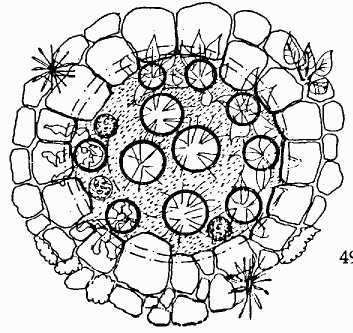
Plan of Tyre Pond
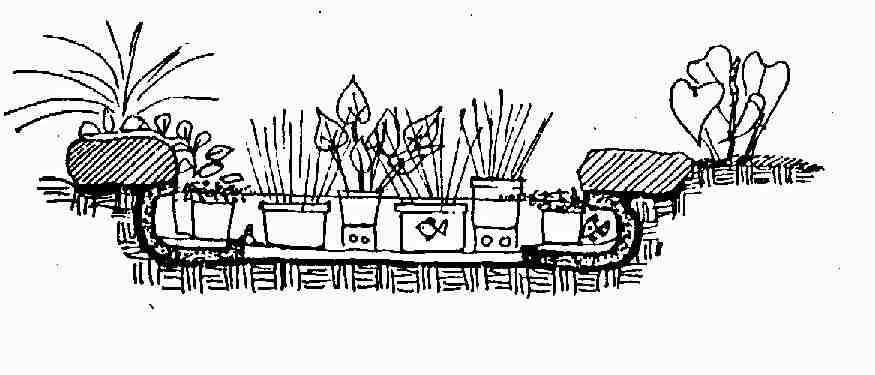
Elevation of Tyre Pond
The demonstration site will also provide opportunities for making the connections between our lifestyles and those of people overseas. Urban agriculture has been declining all over the planet as more traditional farmland and market gardens are resumed for housing developments. The demonstration site activities will make connections to land ownership and the loss of small family farms, both in Australia and overseas, with the resulting settlement on marginal lands leading to land degradation and desertification. The loss of urban agriculture increases our dependance on imported food, raising issues of transport energy use; and cashcropping replacing production for local consumption overseas and in our hinterland.
This outdoor part of the complex will include displays of various composting methods, a worm farm, a small recycling depot, and possibly some community gardens. The site will include a range of demonstration gardens such as Native Foods & Medicines Forest, a Mandala vegetable garden, a Food Forest with bees and poultry, a Herb Spiral and a Senses Maze garden. Each of these gardens is described in detail below. Many of these gardens could be on public land adjacent to the site as they could be accessible at all times. Revegetation projects will be geared to the features of the site.
Focus: Suburban solutions and better use of public land. Basic Ecological Principles
Format: Working Bees, Open Days, Workshops and Courses.
Activities:
Process:Cycling of nutrients; importance of humus to plant life; role of decomposer micro-organisms; soil structure and composition.
Our urban ecosystems have failed to make the final link in the cycle, that of decomposition. Materials and nutrients are locked up in landfill sites rather than being reused, or decomposed and re-cycled. Composting kitchen and garden scraps removes much of the urban waste stream while returning nutrients to the soil. Compost is used in improving water holding capacity and soil structure so that poor soils can be used for urban food production.
The composting demonstration will compare different composting methods and containers. Organic matter will be available from weeding the gardens as well as from a garden waste shredder at the recycling depot. The composting process shows how micro-organisms decompose materials. The compost will be used to improve the soil on site and any excess compost will be bagged and sold to raise funds for the rest of the demonstration site.
The worm farm will demonstrate how larger organisms decompose materials. The worm castings will be used to raise seedlings and as a soil improver. Excess worms can be released on site to improve the soil or used to feed fish. The whole composting demonstration will be located close to the recycling depot so that the links between the two activities become obvious.
Requirements:
Process:Cycling of raw materials; Reuse.
Recycling reduces the waste stream and the demand for landfill sites. It also reduces the demand for resources. The depot will rely on donations of recyclables from people who live locally and/or who support the project. Aluminium cans, metals and glass are usually purchased by recycling companies. Paper can be recycled on site, either in the gardens as sheet mulch, or in papermaking and papiermache workshops.
Requirements:
Process:Water as essential nutrient in ecosystems; reuse of materials
This garden is used to grow water plants such as watercress, water chestnut, arrowhead and kang kong. It demonstrates an attractive and productive way to recycle large tyres; encourages people to eat a wider variety of foods, particularily those adapted to the subtropics; and raises the issues of water quality in countries where these vegetables are an important part of the diet. It will become a water source for local birds, essential to pest control in the Food Forest and Mandala Garden.
Requirements:
|
 Plan of Tyre Pond  Elevation of Tyre Pond |
Process:Interrelationships; Communities, Assemblages; Stacking
The food forest demonstrates a method for growing fruit without the use of pesticides and herbicides, in contrast to monoculture cropping which requires heavy inputs of fertilisers and pesticides, usually provided by transnational corporations which also dominate the seed and food processing markets. The issues of food transport energy use to provide us with out-of-season fruit can be made while participants walk through this forest which will provide some fruit all year round.
A food forest is designed to grow fruit and other crops in a complex system of plants occupying various niches. Fruit trees and shrubs, nitrogen fixing shrubs, groundcover insect repellant herbs and fruiting vines are placed together in assemblages which mimic those found in other forests. Bees will be housed within the food forest to improve pollination and increase yields. Poultry will be allowed to freerange through it to remove windfall fruit and ferilise the soil. The trees will be surrounded by a mulch of stones to prevent root damage by scratching poultry. Plants chosen are varieties suitable for the climate and soil type to minimise pest problems and watering requirements. A small clearing within the area will be used as an outdoor seating area for group discussions.
Requirements:
Process:Life cycles; Energy flows - food chain; edge effect
The mandala garden has been constructed in many sites around the world as a demonstration of Permaculture principles. The original garden was designed and constructed by permaculturalists in India, based on work by the East-West Institute in Hawaii and the samaka gardens of the Philippines. It demonstrates the application of lessons from our project partners in our own community.
This version of the garden has five keyhole beds of vegetables, flowers and herbs, five fruit trees with barrier plantings of lemongrass and comfrey and a central seat. The garden will be constructed by participants of a seperate workshop. School groups will use this garden for activities which demonstrate life cycles such as propogating seed, planting and harvesting.
The person or people undertaking the upkeep of the garden could receive some of the produce for their own use as well as supplying the kiosk with salad vegetables and the processing workshops with produce.
Requirements:
Process:Adaptation & diversity of forms; Microclimates.
This garden will provide the opportunity to raise the issues of different human lifestyles in different climates. The herb spiral is a small garden which will fit into even the tiniest backyard and provide a supply of fresh herbs for the kitchen. The shape of the herb spiral creates microclimates within a very small area, hot and sunny on top and damp and shaded at the base. The garden is planted so that those herbs requiring good drainage and full sun are placed on the highest level and those requiring damp semishaded positions on the lower levels. The herbs are chosen to demonstrate the different forms plants take to adapt to their sites, eg. Rosemary has fine waxy needlelike leaves while French Sorrel has broad soft leaves.
Requirements:
|
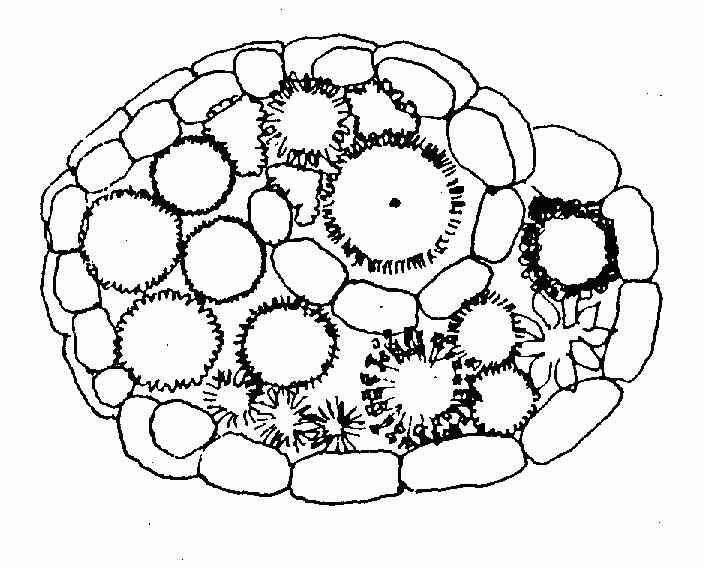 Plan of Herb Spiral 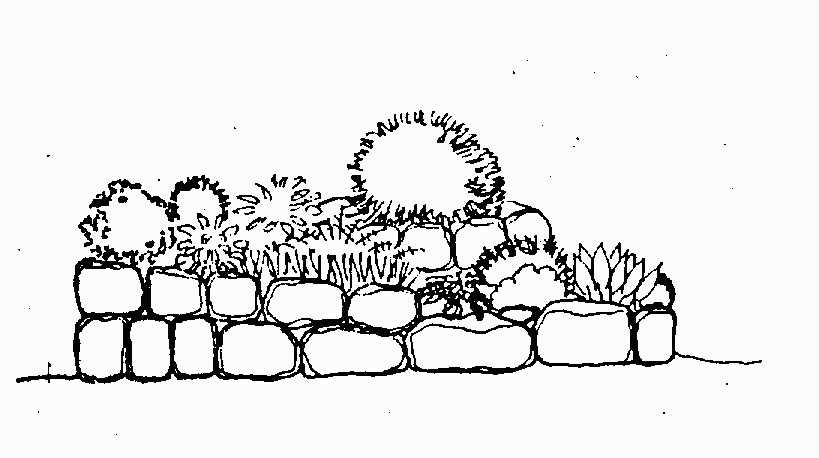 Elevation of Herb Spiral |
Process:Habitat and niche; interrelations, particularily people and environment
The aim of this demonstration is to increase appreciation of the value of forests, in their role as a food source for their inhabitants as well as air filters for the global ecosystem. The destruction of forests has left many indigenous people homeless and without their traditional source of food. Hunter-gatherer systems which have survived for centuries have some lessons for us in our attempts to create sustainable economies. One of these is using indigenous food plants which are adapted to local conditions. These plants require less watering and fertilising than exotic plants which are adapted to different conditions. Great savings of energy could be made if some of our diet was replaced with native foods. As this garden would use local food plants, it could be used by Aboriginal people in passing on their cultural traditions, both within their own community and to the wider community.
Nesting boxes, hollow logs, piles of stones and a pond will speed up the recolonisation of the forest by creating a habitat for for native wildlife. The forest will then become the basis for activities looking at the interrelations between plants and animals and the succession of species.
Requirements:
Process:Basic constituents of ecosystems; Immersion & Contemplation; Symbolism, identity & meaning
The Maze has been used in many cultures since ancient times as a ritual to focus participants on their inner world and on their connections with the rest of their ecosystem. It will be used here for the same reasons as well as to provide a quiet retreat. It will be hidden in a clearing in the Food forest or the Native Foods forest. The Senses Maze will take the form of the ancient Cretan Maze with its four arms representing the four basic constituents of ecosystems - Earth, Air, Fire & Water. A symbolic sculpture at the end of each arm will denote the element:
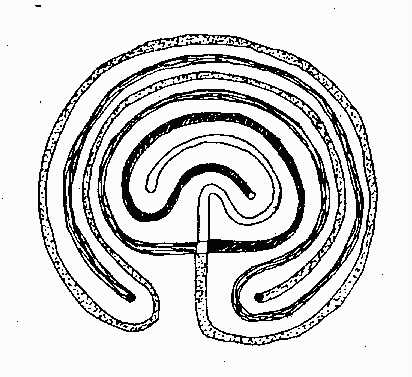 Cretan Maze Pattern |
Earth: A lichen covered rock will symbolise the creation of soils. Air: A set of wind chimes will symbolise air flow. Fire: A sundial will symbolise the source of our energy and its cyclic changes over time. Water: A fountain within a bowl will symbolise the water flowing and cycling through the system. |
All five senses will be activated while walking the Maze: Hearing by the sounds of the windchime and fountain; Touch, by the textures of plants and pathway; Smell, by the scented flowers and foliage; Taste, by the flavours of edible herbs; Sight by the play of light and shade as well as the variety of colours and textures.
Requirements:
This garden will be undertaken seperately as a work of Landform Art. It will require further concept development and a seperate funding proposal.
Process: Processors; Energy flows; Use of appropriate technology
These activities include preserving foods and producing some toiletries and cosmetics locally. Issues of agribusiness control of processing and marketing; the problems of food preservation in poor communities; empowering people to regain skills and provide for some of their own needs.
The kitchen will demonstate low-energy and appropriate appliances and innovative ways of preparing, cooking and storing the produce from the site and elsewhere. Efficient cooking systems developed overseas and hand and pedalpowered appliances will give participants experience that these solutions are possible.
Requirements:
The venue is a room which will be available for displays by groups on their particular issue of concern, or by ethnic groups on their culture and history. It will also be used for theatre, art or craft exhibitions, workshops or meetings on related topics. A multipurpose space such as this allows community groups to meet, fundraise and undertake their own community education programmes. The venue will allow connections between the groups using the space to grow and will help to broaden the focus of groups by exposing them to the issues and activities of other groups.
Focus: Multiculturalism, empathy and challenging preconceptions.
Format: Festivals, Performances, Exhibitions & Workshops.
Activities:
Requirements:
The demonstration housing will showcase existing energy efficient appliances; shading and other climate controls; and other simple lifestyle changes such as waste minimisation. If possible the house will be made up of seperate living units as a demonstration of appropriate medium density housing. One unit could then be set aside as accommodation for visiting teachers or workers. The garden around the housing will be an edible landscape, demonstrating intensive gardening techniques.
Focus: Housing retrofit, energy consumption, quality lifestyle.
Format: Open Days, Displays. Visitors accomodation.
Activities: